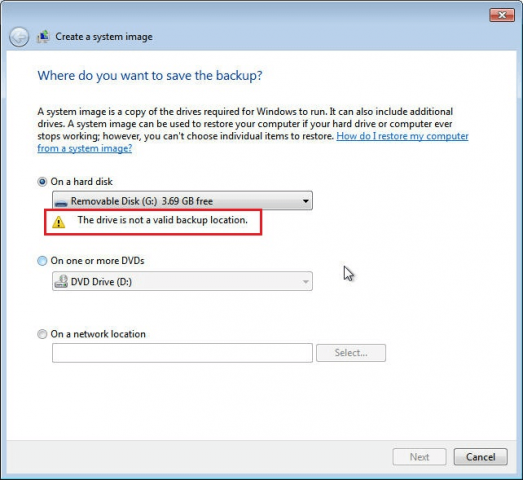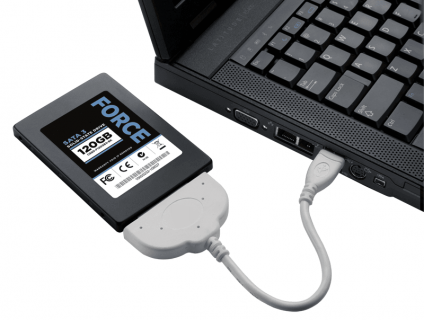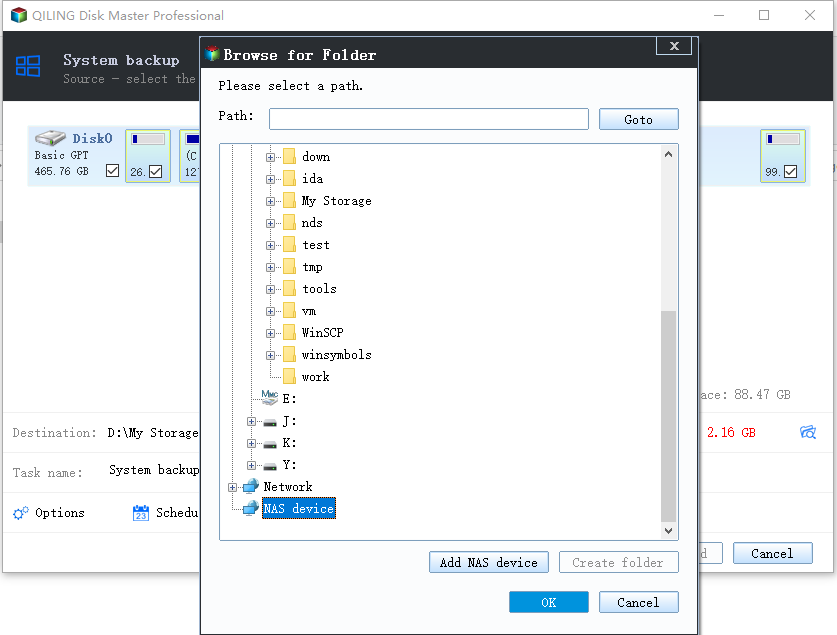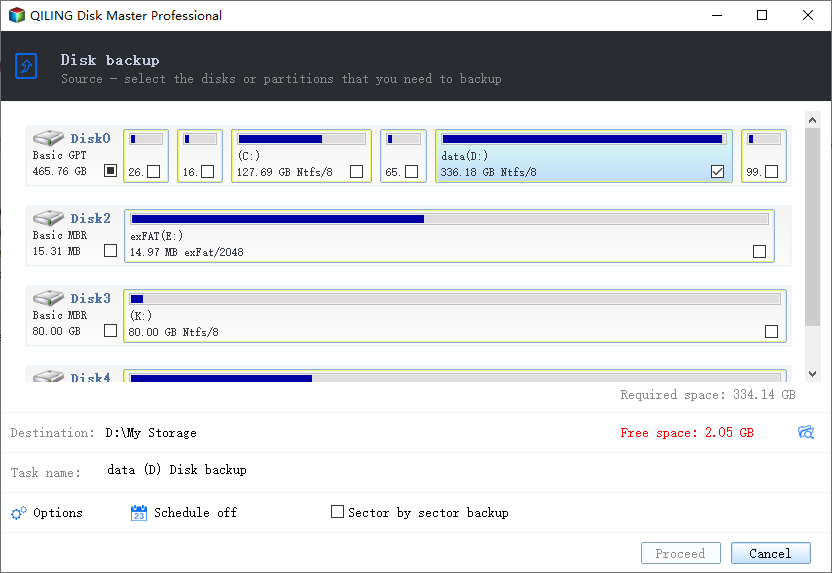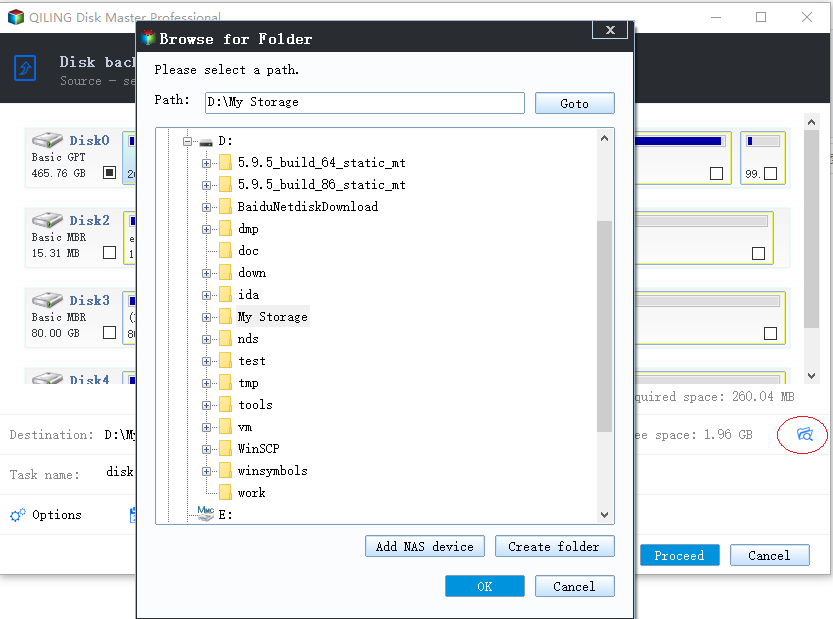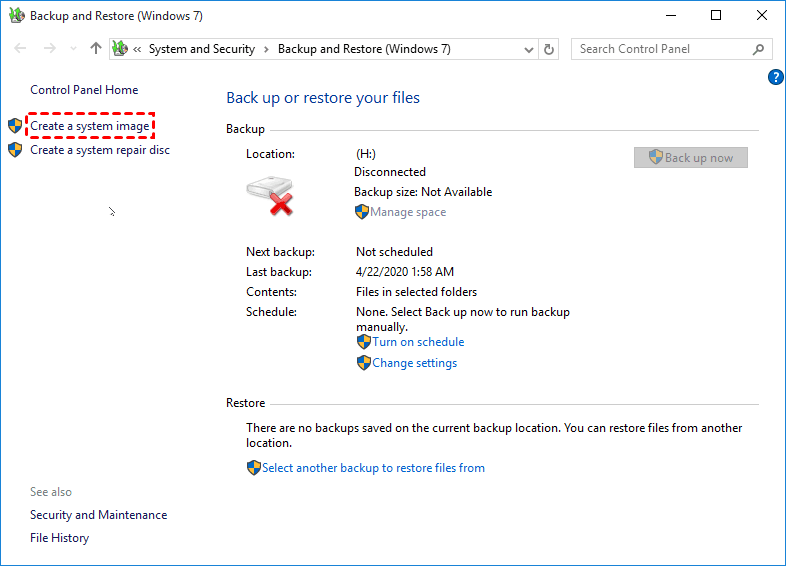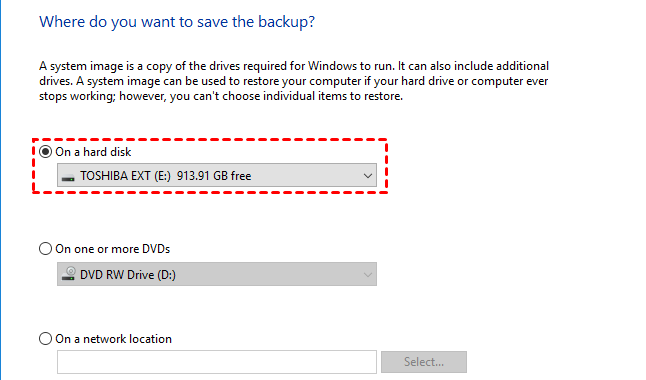Backup Windows 10 to External Hard Drive Securely (3 Ways)
Case: Failed to backup Windows 10 to external hard drive
I’d like to create a full backup in Windows 10 to external hard drive, and later an incremental backup or differential backup would be better. Tried to use Windows 10 backup and restore utility to backup but it seems like the drive cannot be recognized. Is there any simpler way to backup my Windows 10 operating system to external drive?
Many users want to backup Windows 10 operating system or files to an external hard drive for security or portability, and the first choice may be the built-in Backup and Restore utility.
But there are chances that the drive cannot be recognized especially when creating a system image to an external USB drive, it may return "the drive is not a valid backup location" prompt. Even if the USB is formatted with NTFS file system, things won't be much better.
So, is it a good idea to back up windows 10 computer to external hard drive, and how to do it without such errors?
Benefits of backing up Windows to external hard drive
Backing up Windows 10 means to create a full image of the operating system (or even entire boot drive). It includes system files, configuration and installed programs which can be used to restore a comptuer to a previous state, and therefore resolve system issues.
Despite there are multiple choices of backing up Windows 10, external hard drive is a recommended destination. It is independent of your local drive and therefore prevents backup files from getting corrupted or unaccessable due to hard drive failure, system crash, virus, ransomware like WannaCry, human error, etc. Anytime your computer has a problem, you can connect the external drive to perform a full system recovery.
How to backup Windows 10 to external hard drive securely
To backup Windows 10 computer to external hard drive successfully, there are some things need to be confirmed first, otherwise the backup process will be prone to various problems.
◉ Use effective backup tools and follow right steps.
Windows Backup and Restore does have basic backup features, but there are more limitations on the functionality. For example, it only supports backing up system to an external hard drive formatted with NTFS. So if you are using a FAT32 drive, then you need to format it to NTFS at first.
If you want to avoid such hassles and simplify the whole process, then you can try using more efficient backup tools like Qiling Disk Master Professional. It helps you backup Windows 10 OS as well as files & folders, selected partitions or entire disk to external hard drive with several clicks.
◉ The target drive should be large enough to save the backup image, like 64GB, 128GB, 256 GB.
The "not a valid backup location" error of Backup and Restore usually occurs when you choose a USB flash drive as destination, because earlier USB drives didn’t have enough space and weren’t admitted as storage locations. If you use a large and common external hard drive instead, the problem may not arise.
◉ Make sure the external hard drive can be recognized.
This is also the basis for subsequent operations. If an external hard drive cannot be detect by Windows, there are many possible reasons. You can plug it into another computer, and then plug another drive into your computer to see where the problem really lies.
Way 1. Backup Windows 10 system or files to external drive easily
Qiling Disk Master is a comprehensive backup tool that works with Windows 11, 10, 8.1, 8, 7, Vista and XP, and the supported devices included internal/external drives, network locations (share & NAS), USB flash drive and cloud drive. So not only backing up Windows 10 system/files to external hard drive, you can use it to achieve 3-2-1 backup strategy easily.
- When creating backup, you can set up a schedule based on daily, weekly, monthly, event-triggers, USB plug in.
- You can perform incremental or differential backup that only backs up changed data, or create a retention policy to auto delete older backups.
- There's a Universal Restore feature, you can even restore system image to another computer with different hardware.
- You can also use the cloning featues to migrate Windows 10 to new hard drive with secure boot.
What's more, if you want to create an intact copy of certain files & folders automatically, there's a handy feature called Real-Time Sync. It can sync any changed files from the source directory to the target directory in real time.
Get the 30-Day Free Trial and have a try:
Preparations:
- Connect the external storage to your Windows 10 computer and make sure it can be detected by Windows 10.
- Install and launch Qiling Disk Master Professional.
How to backup Windows 10 to external hard drive (step-by-step):
1. Click Backup on the left side of the interface and then choose System Backup.
2. The Windows 10 OS (all the boot related partitions) will be auto selected by default, you just need to select a backup destinaion.
★Tip: You can also backup Windows 10 to USB flash drive, internal disk, NAS, network share, cloud.
3. Confirm all operations and then click Proceed to backup Windows 10 operating system to external hard drive.
★Useful features:
✍"Options" can be set based on your own needs. It includes the functions of adding comments for image to distinguish it from other images, compressing, encrypting and splitting image file, etc.
✍"Schedule Backup" enables you to automatically backup Windows 10 via daily, weekly, monthly, event triggers or USB plug in.
✍"Backup Scheme" allows you to select backup mode (full/incremental/differential), or set up a rule for automatic backup cleanup.
Do not remove the external hard drive from your Windows 10 computer before the backup is completed. If you want set up an automatic backup job to external hard drive, you need to make sure the drive letter of external drive remain unchanged. It is suggested to permanently assign drive letter to external drive. If you intend to upgrade hard drive from HDD to SSD, please try clone HDD to SSD without reinstalling.
If you want to restore an image file without booting Windows, you can create a recovery environment with Qiling Disk Master in advance. This can add the "Qiling Disk Master Recovery Environment" option to the system boot menu page so that you can select to start the system from the recovery environment to restore images created by Qiling Disk Master.
Way 2. Backup Windows 10 OS to external hard drive for onekey recovery
Qiling Disk Master Professional is a reliable one key recovery software, which allows you to create a factory recovery image and then reset your computer to the default settings. It supports backing up system to Qiling Disk Master Professional partition or other location, such as, external hard drive. The first option is recommended, because it will save the backup image to a real partition but not specify drive letter to avoid any unwanted deletion.
In addition, it still supports adding boot menu as well as specify fast key (F11 or A) to access Qiling recovery environment. In this case, you can directly press F11 or A key to during the system startup process without creating a bootable USB or disc first. And it can be used to all brands of computers(all Windows PCs and Servers), such as, Lenovo, Dell, HP, Acer, etc.
And if your system occupies too much disk space, you can compress image with normal or high compressional level. Also, if your computer has sensitive data that you don't want others to see, you can choose to enable encryption for backups and set a password for it. Then, download the demo version to have a try!
1. Launch disk or partition backup software Qiling Disk Master Professional, click Disk/Partition Backup.
2. Tick Backup system to other location .
- Notes:✎...
- If you want to set compression level or password for the backup image, click Backup Options at the lower location.
- If your system disk has enough space to store your backup image, it's suggested to backup system to Qiling Disk Master Professional partition. Because it's much safer.
3. Click Browse and select external hard drive on the computer. If you don't connect your external disk, please connect it first.
- Note:✎...
- The selected partition in the Advanced option is to store boot files and we call it recovery partition.
4. Confirm all the info and click Proceed. The process will run into reboot mode. please wait patiently and don't stop it.
Way 3. Create Windows 10 image to external hard drive via Backup and Restore
If you prefer to use built-in utility in Windows 10 and have got a suitable external hard drive, then you could create a system image for Windows 10 via Backup and Restore. By the way, if you want to auto backup Windows 10 folders to external drive, File History will be a better option.
How to backup Windows 10 to external hard drive with Backup and Restore:
1. Input backup and restore in Windows 10 search box. And then select Backup and Restore (Windows 7).
2. Click Create a system image on the left side.
3. Choose the external hard drive at the page of “Where do you want to save the backup?” and click Next.
4. Click Start Backup to backup Windows 10 to external hard drive and wait for the process to complete.
★Tip: It may prompt to create a system repair disc which is used to boot computer and troubleshoot the problems when disaster happen. You can create one to realize bootable backup Windows 10.
Wrap up
Backing up Windows 10 to external hard drive is a good way to rescue your crashed system when needed. Even if a disaster happens without any preparation, you can use Qiling Disk Master to create a bootable media on any normally working computer, and then use it to boot the problematic computer into WinPE for further backup or troubleshooting.
If you want to protect unlimited computers within your company, you can pick Qiling Disk Master Technician. With the inbuilt Qiling Image Deploy tool, you are also allowed to deploy/restore system image file on server-side computer to multiple client-side computers over network.
Related Articles
- How to Backup Outlook Emails before Deleting Account (2 Ways)
This tutorial will show you how to backup Outlook emails before deleting account to have peace of mind knowing that you are in control of your data. - The Best Way to Backup Raspberry Pi SD Card in Windows
Want to backup Raspberry Pi SD card in Windows? You can achieve this goal easily with the best free backup software – Qiling Disk Master Standard. - Bootrec Fixboot Element Not Found in Windows 7, 8, 10- Fixed
Windows start problem has not been solved and the bootrec fixboot element not found error has arisen. You must be very upset. Click on this article and learn to fix it. - Centralized Backup Software - Backup All Computers on Network
Any enterprise backup software can create centralized backup for all computers within LAN simultaneously? Here is an example along with brief tutorial.
